

St
Paul's Whitechapel CE Primary
School 'for the children of seamen'
school website
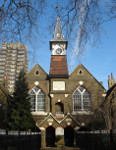


 In
the 19th century, St George-in-the-East and its various mission
churches were active in building and running schools for the children
of the area. With the coming of the Board (county, now
'community') Schools, this involvement was gradually lost. But in 1971,
when the parish of St Paul Dock Street was joined to St
George-in-the-East, and we became the parish of 'St George-in-the-East
with St Paul', we were glad to acquire responsibility once again for
a voluntary aided (VA) church school, whose history is told here
in connection with its founder, Dan Greatorex - including his claim
that it was at this school that the first-ever free and healthy school dinners were
served. Left is the 'old' entrance; far right is the lower infants class in 1952, with Fr Joe Williamson in the background.
In
the 19th century, St George-in-the-East and its various mission
churches were active in building and running schools for the children
of the area. With the coming of the Board (county, now
'community') Schools, this involvement was gradually lost. But in 1971,
when the parish of St Paul Dock Street was joined to St
George-in-the-East, and we became the parish of 'St George-in-the-East
with St Paul', we were glad to acquire responsibility once again for
a voluntary aided (VA) church school, whose history is told here
in connection with its founder, Dan Greatorex - including his claim
that it was at this school that the first-ever free and healthy school dinners were
served. Left is the 'old' entrance; far right is the lower infants class in 1952, with Fr Joe Williamson in the background.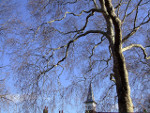 In a VA school,
church authorities are the trustees of the building. The trust deeds
and 'instrument of government' determine the church foundation, which
provides the majority of the governors - who are variously appointed by
the parish, deanery, diocese and the existing foundation governors. The
governors appoint and employ the staff; decide the admissions criteria
(in consultation with the local authority and the diocese) and offer
places; determine the policy for religious education and worship; and
have various other powers, such as to set school holidays (this is a
live issue in Tower Hamlets, where most schools close for the two Eid
holidays; after careful consideration, we do not, but encourage
children to celebrate the festivals in school as well as with their
families.)
In a VA school,
church authorities are the trustees of the building. The trust deeds
and 'instrument of government' determine the church foundation, which
provides the majority of the governors - who are variously appointed by
the parish, deanery, diocese and the existing foundation governors. The
governors appoint and employ the staff; decide the admissions criteria
(in consultation with the local authority and the diocese) and offer
places; determine the policy for religious education and worship; and
have various other powers, such as to set school holidays (this is a
live issue in Tower Hamlets, where most schools close for the two Eid
holidays; after careful consideration, we do not, but encourage
children to celebrate the festivals in school as well as with their
families.)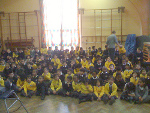
 We greatly value
our links with the school, and take seriously our involvement with its
governance. Alongside church members, Trowers and Hamlins
whose London office was until recently near the school, and other firms in the city,
provide governors who bring both expertise and real commitment to the
task. The
Rector leads weekly assemblies, and is constantly amazed by the
confidence and thoughtfulness of the children. At St George's-tide, he
sang 'When a knight won his spurs' and asked them what dragons we have
to fight today. A year 4 hand went up - 'racism', she said without
hesitation. And a year 2 pupil recently asked him 'what party will you
be voting for in the election?' The fact that over 85% of the pupils are
from Muslim families is not a problem - together, we take issues of
faith seriously, and their knowledge of the Christian faith, and
splendid Christmas and Easter presentations, would put many
'Christian-majority' schools to shame. They come to church twice a term
for special services, as well as for curriculum activities. The
school was judged 'outstanding' in all four areas of its most recent
denominational inspection [compare the episode of 'Rev' on this subject!], and Canterbury Christ Church University regularly
brings groups of aspiring heads to the school, which they
judge to be 'inspirational' because the staff team is very strong (and,
incidentally, has several male teachers and teaching assistants).
Major building work was completed in 2011 [the picture right predates the new early years unit and glazed entrance], and was re-dedicated
by the Bishop of Stepney in January 2012.
All in all, the future looks bright.
We greatly value
our links with the school, and take seriously our involvement with its
governance. Alongside church members, Trowers and Hamlins
whose London office was until recently near the school, and other firms in the city,
provide governors who bring both expertise and real commitment to the
task. The
Rector leads weekly assemblies, and is constantly amazed by the
confidence and thoughtfulness of the children. At St George's-tide, he
sang 'When a knight won his spurs' and asked them what dragons we have
to fight today. A year 4 hand went up - 'racism', she said without
hesitation. And a year 2 pupil recently asked him 'what party will you
be voting for in the election?' The fact that over 85% of the pupils are
from Muslim families is not a problem - together, we take issues of
faith seriously, and their knowledge of the Christian faith, and
splendid Christmas and Easter presentations, would put many
'Christian-majority' schools to shame. They come to church twice a term
for special services, as well as for curriculum activities. The
school was judged 'outstanding' in all four areas of its most recent
denominational inspection [compare the episode of 'Rev' on this subject!], and Canterbury Christ Church University regularly
brings groups of aspiring heads to the school, which they
judge to be 'inspirational' because the staff team is very strong (and,
incidentally, has several male teachers and teaching assistants).
Major building work was completed in 2011 [the picture right predates the new early years unit and glazed entrance], and was re-dedicated
by the Bishop of Stepney in January 2012.
All in all, the future looks bright.  The poet Isaac
Rosenberg
was the son of Barnett and Anna, Lithuanian Jewish immigrants who had
settled in Bristol,
where he was born in 1890, before moving to the East End. From
1897-1900, when they were living at 47 Cable Street, he was a pupil at
St Paul's School: to their disappointment, there were no places at the
Jewish Free School when they arrived from Bristol, but Isaac appears to
have flourished here, and the school regime in those days was quite
enlightened, in respect to accommodating Jewish pupils and allowing
their absence for the high holy days (and also with regard to corporal
punishment). There is more detail of these years in Jean Moorcroft
Wilson Isaac Rosenberg - The Making of a Great War Poet: a New Life
(Weidenfeld & Nicholson 2007) from which this contemporary drawing
of the school is taken. A change in family fortunes forced a move to
Jubilee Street and he attended
Baker Street School, where Winifreda Seaton was an inspiring teacher.
He showed great talent for drawing and painting - the head Mr Usherwood
arranged art classes at Stepney Green Art School - and he began writing
poetry. Morley Dainow, the librarian at Whitechapel Library, encouraged
him and guided his choice of reading. But money was short, so he left
school at 14 and became an apprentice engraver at Carl Hentschel's firm
in Fleet Street. However, he managed to attend evening classes at
Birkbeck College, winning prizes for his nude studies in pencil and
then in oils. Aged 21, he won a scholarship at the Slade and was able
to study full-time. Ill health, exacerbated by London smog, forced a
rest cure, first in Bournemouth then with his sister Annie in Cape
Town, whence he returned when war was declared, earning the £15 fare
from a painting commissioned by Sir Herbert Stanley. Most of his
paintings were lost overboard in a storm in Cape Town harbour, and back
in London he struggled to make ends meet, despite finding increasing
fame as a poet. Just before he signed up in the army in 1915 he
published 'Youth', a small collection of poems. Having continued to
write poetry in the trenches, Private Rosenberg 22311, 1st King's Own
Royal Lancasters, was killed in action on a dawn patrol on 1 April
1918. He was the only one of the major war poets to come from a
deprived
background [see here for the connection of a curate of St Paul's with Wilfred Owen.] Here, here, and (from the War Poets Association) here are further accounts of his life and significance. The group of local
Jewish writers and artists, which included the painters Mark Gertler and David Bomberg, is now known as the 'Whitechapel Boys'.
The poet Isaac
Rosenberg
was the son of Barnett and Anna, Lithuanian Jewish immigrants who had
settled in Bristol,
where he was born in 1890, before moving to the East End. From
1897-1900, when they were living at 47 Cable Street, he was a pupil at
St Paul's School: to their disappointment, there were no places at the
Jewish Free School when they arrived from Bristol, but Isaac appears to
have flourished here, and the school regime in those days was quite
enlightened, in respect to accommodating Jewish pupils and allowing
their absence for the high holy days (and also with regard to corporal
punishment). There is more detail of these years in Jean Moorcroft
Wilson Isaac Rosenberg - The Making of a Great War Poet: a New Life
(Weidenfeld & Nicholson 2007) from which this contemporary drawing
of the school is taken. A change in family fortunes forced a move to
Jubilee Street and he attended
Baker Street School, where Winifreda Seaton was an inspiring teacher.
He showed great talent for drawing and painting - the head Mr Usherwood
arranged art classes at Stepney Green Art School - and he began writing
poetry. Morley Dainow, the librarian at Whitechapel Library, encouraged
him and guided his choice of reading. But money was short, so he left
school at 14 and became an apprentice engraver at Carl Hentschel's firm
in Fleet Street. However, he managed to attend evening classes at
Birkbeck College, winning prizes for his nude studies in pencil and
then in oils. Aged 21, he won a scholarship at the Slade and was able
to study full-time. Ill health, exacerbated by London smog, forced a
rest cure, first in Bournemouth then with his sister Annie in Cape
Town, whence he returned when war was declared, earning the £15 fare
from a painting commissioned by Sir Herbert Stanley. Most of his
paintings were lost overboard in a storm in Cape Town harbour, and back
in London he struggled to make ends meet, despite finding increasing
fame as a poet. Just before he signed up in the army in 1915 he
published 'Youth', a small collection of poems. Having continued to
write poetry in the trenches, Private Rosenberg 22311, 1st King's Own
Royal Lancasters, was killed in action on a dawn patrol on 1 April
1918. He was the only one of the major war poets to come from a
deprived
background [see here for the connection of a curate of St Paul's with Wilfred Owen.] Here, here, and (from the War Poets Association) here are further accounts of his life and significance. The group of local
Jewish writers and artists, which included the painters Mark Gertler and David Bomberg, is now known as the 'Whitechapel Boys'.
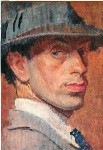
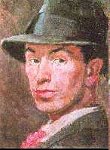

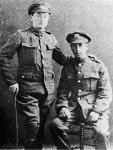
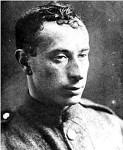
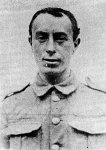 Here
are three self-portraits - the first from 1915 now in the National
Potrait Gallery, the third sketched in France - and three photographs
(one with his brother Elkon in 1917) from the Imperial War Museum.
Here
are three self-portraits - the first from 1915 now in the National
Potrait Gallery, the third sketched in France - and three photographs
(one with his brother Elkon in 1917) from the Imperial War Museum.
Below are manuscripts of the poems Spring, and (written on Salvation Army notepaper) Daughters of War.

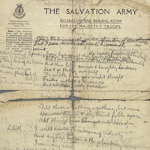
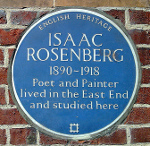 Rosenberg's poem The Jew describes
the racism he experienced, not at school, but in the trenches:
Rosenberg's poem The Jew describes
the racism he experienced, not at school, but in the trenches:
| Moses, from whose loins I sprung, Lit by a lamp in his blood Ten immutable rules, a moon For mutable lampless men. |
The blonde, the bronze, the ruddy, With the same heaving blood, Keep tide to the moon of Moses. Then why do they sneer at me? |
The blue plaque is on the outside wall of the Whitechapel Gallery. In 1995, when
the British Library was relocating, a bundle of 34 letters and 18 draft
poems was discovered among the papers of former curator and fellow-poet
Laurence Binyon, who had been Rosenberg's mentor; they were published
as Poetry out of my Head and Heart. There are currently plans to erect a statue - possibly at Birkbeck College - and mark his forthcoming centenary in other ways.
I WAS A FIREMAN / FIRES WERE STARTED

 When the Second
World War broke out, Docklands was a prime target and many children
were evacuated (though many of them later returned). The school was
used as a fire station. Right are images of firemen entering Wellclose Square from Ship Alley, and a '14Y Heavy Unit' driving into the playground.
When the Second
World War broke out, Docklands was a prime target and many children
were evacuated (though many of them later returned). The school was
used as a fire station. Right are images of firemen entering Wellclose Square from Ship Alley, and a '14Y Heavy Unit' driving into the playground.
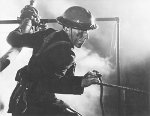


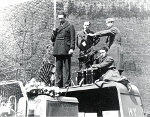 Some scenes from I was a Fireman, also released as Fires Were Started, were
shot in 1942-43 around the school. It is the story of a day in the life
of an Auxiliary Fire Service unit (a volunteer service set up in 1938)
tackling a Docklands munitions factory at the height of the Blitz, and
was the work of the innovative director Humphrey Jennings
(1907-50) [right on location], who used AFS members (including Cyril Demarne) rather than
professional actors. Produced for the Ministry of Information by the Crown
Film Unit (until 1940 the GPO Film Unit), as propaganda, it has
acquired iconic status in the annals of social realism. Dilys Powell in the Sunday Times called it moving and terrifying. Lindsay Anderson wrote in 1954 that Jennings was the only true poet the British cinema has yet produced. After the Battle (no.161, August 2013) includes this more detailed article [far right] about the film and its background.
Some scenes from I was a Fireman, also released as Fires Were Started, were
shot in 1942-43 around the school. It is the story of a day in the life
of an Auxiliary Fire Service unit (a volunteer service set up in 1938)
tackling a Docklands munitions factory at the height of the Blitz, and
was the work of the innovative director Humphrey Jennings
(1907-50) [right on location], who used AFS members (including Cyril Demarne) rather than
professional actors. Produced for the Ministry of Information by the Crown
Film Unit (until 1940 the GPO Film Unit), as propaganda, it has
acquired iconic status in the annals of social realism. Dilys Powell in the Sunday Times called it moving and terrifying. Lindsay Anderson wrote in 1954 that Jennings was the only true poet the British cinema has yet produced. After the Battle (no.161, August 2013) includes this more detailed article [far right] about the film and its background.MOTHER GOOSE COMES TO CABLE STREET
 In
1977 the Children's Rights Workshop - a London-based voluntary
group with aimed to extend the intellectual, emotional and material
choices available to children, including their literature, produced Mother Goose comes to Cable Street: Nursery Rhymes for today
(Kestrel 1977, and a Picture Puffin in 1980), selected by Rosemary
Stones and Andrew Mann, with illustrations by the well-known local
figure Dan Jones, who still lives on Cable Street. Here is the
endpaper, which is set in St Paul's playground.
In
1977 the Children's Rights Workshop - a London-based voluntary
group with aimed to extend the intellectual, emotional and material
choices available to children, including their literature, produced Mother Goose comes to Cable Street: Nursery Rhymes for today
(Kestrel 1977, and a Picture Puffin in 1980), selected by Rosemary
Stones and Andrew Mann, with illustrations by the well-known local
figure Dan Jones, who still lives on Cable Street. Here is the
endpaper, which is set in St Paul's playground.
| from The Times, 5 December 2008 Pick and mix: Case study |
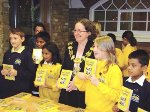 Year
6 pupils made a DVD for parents with ideas and suggestions to help
parents get involved with the children's reading skills. It was
distributed throughout the borough, and to church schools around the
diocese.
Year
6 pupils made a DVD for parents with ideas and suggestions to help
parents get involved with the children's reading skills. It was
distributed throughout the borough, and to church schools around the
diocese. 
 'Sing Up' - children (in yellow) performing with other school and adult choirs at
The Barbican
'Sing Up' - children (in yellow) performing with other school and adult choirs at
The Barbican The
Olympic mascots Mandeville and Wenlock were unveiled at the school;
they have attracted some criticism, but the children managed to be
positive about them, and in the process have learned about Olympic
history.
The
Olympic mascots Mandeville and Wenlock were unveiled at the school;
they have attracted some criticism, but the children managed to be
positive about them, and in the process have learned about Olympic
history. Once a week, for the past 10 years during term time, around 40 members
of staff from law firm Trowers & Hamlins have left their Tower
Hill offices for the short journey to St Paul's Whitechapel C of E
Primary School. Here, they have spent their lunch hour helping some of
the children to improve their reading, comprehension and fluency in
English. The firm has lent considerable support to St Paul's in other ways over
the past decade, including funding for school trips, building projects
and not least, the expertise of Partner, Ian Graham who has been chair
of the board of governors for the past five years. This lengthy relationship, described by Tower Hamlets Education Business Partnership Director Mike Tyler as 'a
model corporate partnership', was celebrated recently at a special
reception at the firm's offices. As well as its involvement with St Paul's, Trowers & Hamlin
volunteers have been regular supporters of the EBP's Getting Ahead
work-related learning programme. Trowers & Hamlin Partner, Ian Graham said We have an excellent
relationship with St Paul's. The children are fantastic, they really
enjoy the interaction with their Reading Partners. The Headteacher
Terry Bennett and all his staff make us feel very welcome when we are
at the school. The reading scheme is a great way for people from our
firm to get involved in supporting the local community.
Once a week, for the past 10 years during term time, around 40 members
of staff from law firm Trowers & Hamlins have left their Tower
Hill offices for the short journey to St Paul's Whitechapel C of E
Primary School. Here, they have spent their lunch hour helping some of
the children to improve their reading, comprehension and fluency in
English. The firm has lent considerable support to St Paul's in other ways over
the past decade, including funding for school trips, building projects
and not least, the expertise of Partner, Ian Graham who has been chair
of the board of governors for the past five years. This lengthy relationship, described by Tower Hamlets Education Business Partnership Director Mike Tyler as 'a
model corporate partnership', was celebrated recently at a special
reception at the firm's offices. As well as its involvement with St Paul's, Trowers & Hamlin
volunteers have been regular supporters of the EBP's Getting Ahead
work-related learning programme. Trowers & Hamlin Partner, Ian Graham said We have an excellent
relationship with St Paul's. The children are fantastic, they really
enjoy the interaction with their Reading Partners. The Headteacher
Terry Bennett and all his staff make us feel very welcome when we are
at the school. The reading scheme is a great way for people from our
firm to get involved in supporting the local community.
 Each year Trowers and Hamlins sponsor a competition to design a
Christmas card, and give prizes for each year group, with an overall
winner whose design becomes their corporate card which they send out to
all their contacts. The winner in 2010 [left] was
Zarin Ahmed of year 6 (who
also played the central role of 'Innkeeper's Wife' in the school
Christmas production); the firm made donations to Macmillan Cancer
Support and Red Crescent. The 2011 winner was Fahmid Ahmed of year 4,
and donations were made to Macmillan Cancer Support and Médecins Sans
Frontières.
Each year Trowers and Hamlins sponsor a competition to design a
Christmas card, and give prizes for each year group, with an overall
winner whose design becomes their corporate card which they send out to
all their contacts. The winner in 2010 [left] was
Zarin Ahmed of year 6 (who
also played the central role of 'Innkeeper's Wife' in the school
Christmas production); the firm made donations to Macmillan Cancer
Support and Red Crescent. The 2011 winner was Fahmid Ahmed of year 4,
and donations were made to Macmillan Cancer Support and Médecins Sans
Frontières.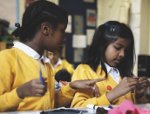 The
National Society's newsletter includes this picture from our school, as
part of an article about making banners for its bicentenary service in
Westminster Abbey on 14 October (though that is not actually what these girls are doing!)
The
National Society's newsletter includes this picture from our school, as
part of an article about making banners for its bicentenary service in
Westminster Abbey on 14 October (though that is not actually what these girls are doing!)|
The
new and refurbished school buildings Remember also Edith Wyeth, governor and friend of the school for many years |

 Deputy headteacher Sarah Meares writes:
Our school was offered the opportunity to work with a poet from the
Poetry Society a month or so ago. The poet, Coral Rumble, came into
school and worked with our year 5 children to write poems about
'Friendship Trees'. Different poets worked in several different schools
around the country on the same subject and their poems were given to
another poet who worked on them to produce a poem to go around the
bottom of the Christmas tree in Trafalgar Square. Following Coral's
visit, I had a call from the Poetry Society asking us if we'd like to
take 3 children to Norway to see the tree being felled in the forests
around Oslo. So, early on Thursday morning, I took Yassin, Faridah and
Aysha to Oslo for an overnight trip. We were very well looked after by
a lady from the Oslo Mayor's Office who showed us round. This included
a trip to the Edvard Munch museum to see 'The Scream', a night in a
hotel in Oslo and then on Friday we were taken to the forest to watch
the tree being felled. We met the Mayor of Oslo and the Mayor of
Westminster Council who had travelled to Norway to take part in the
ceremony. After the tree was felled we were taken to the British
Ambassador's residence for tea and then made our way home again. It was
such an exciting experience for our children and I was so proud of them
- they coped incredibly well in so many strange and exciting
surroundings.
Deputy headteacher Sarah Meares writes:
Our school was offered the opportunity to work with a poet from the
Poetry Society a month or so ago. The poet, Coral Rumble, came into
school and worked with our year 5 children to write poems about
'Friendship Trees'. Different poets worked in several different schools
around the country on the same subject and their poems were given to
another poet who worked on them to produce a poem to go around the
bottom of the Christmas tree in Trafalgar Square. Following Coral's
visit, I had a call from the Poetry Society asking us if we'd like to
take 3 children to Norway to see the tree being felled in the forests
around Oslo. So, early on Thursday morning, I took Yassin, Faridah and
Aysha to Oslo for an overnight trip. We were very well looked after by
a lady from the Oslo Mayor's Office who showed us round. This included
a trip to the Edvard Munch museum to see 'The Scream', a night in a
hotel in Oslo and then on Friday we were taken to the forest to watch
the tree being felled. We met the Mayor of Oslo and the Mayor of
Westminster Council who had travelled to Norway to take part in the
ceremony. After the tree was felled we were taken to the British
Ambassador's residence for tea and then made our way home again. It was
such an exciting experience for our children and I was so proud of them
- they coped incredibly well in so many strange and exciting
surroundings. 'This is an outstanding school...'
'This is an outstanding school...'Back to Dan Greatorex | Back to St Paul Dock Street